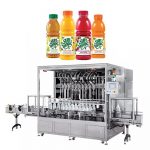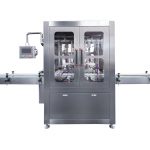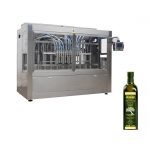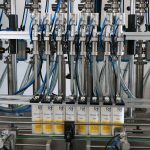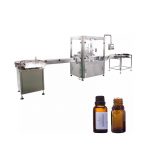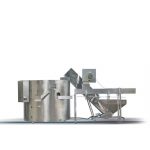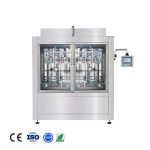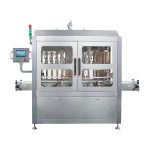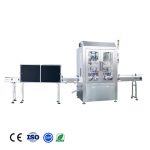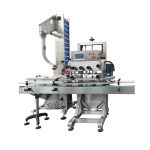A quantitative filling machine is a type of automated equipment that is used to dispense precise amounts of liquids, pastes, or other flowable substances into containers or packages. These machines are commonly used in the food, pharmaceutical, and chemical industries to fill containers with products such as sauces, syrups, creams, and liquids. They are also used in the cosmetics industry to fill bottles with lotions, creams, and other products.
There are several different types of quantitative filling machines, each designed to handle specific types of products and fill sizes. Some common types include:
- Piston fillers: These machines use a piston to dispense product into containers. They are typically used for thicker products such as sauces and pastes, and are capable of filling a wide range of container sizes.
- Gravity fillers: These machines use gravity to dispense product into containers. They are often used for thin liquids such as water and juices, and are typically capable of filling containers at high speeds.
- Pump fillers: These machines use a pump to dispense product into containers. They are often used for products with higher viscosities, such as creams and lotions, and are capable of filling a wide range of container sizes.
- Volumetric fillers: These machines use a measurement device, such as a cylinder or a rotary valve, to dispense precise amounts of product into containers. They are often used for products that require accurate dosing, such as pharmaceuticals and chemicals.
In order to properly operate a quantitative filling machine, it is important to follow a few basic steps:
- Prepare the machine: Before starting the filling process, make sure the machine is properly set up and that all necessary components, such as filling nozzles, conveyors, and containers, are in place. Check the machine's settings to ensure that it is set to dispense the correct amount of product.
- Load the product: If the machine is not already filled with product, load the product into the machine using the appropriate method. This may involve transferring the product from a tank or container, or manually filling the machine using a pump or other dispensing device.
- Test the machine: Before starting the filling process, it is important to test the machine to ensure that it is working properly. This may involve running a few test fills to check the accuracy of the filling process and ensure that the machine is dispensing the correct amount of product.
- Start the filling process: Once the machine has been prepared and tested, start the filling process by activating the filling mechanism. This may involve pressing a start button, activating a switch, or triggering the machine in some other way.
- Monitor the filling process: As the filling process progresses, it is important to closely monitor the machine to ensure that it is working properly and that the filling process is accurate. This may involve checking the machine's controls, measuring the amount of product dispensed, or visually inspecting the containers being filled.
- Maintain the machine: Proper maintenance is essential to ensure that a quantitative filling machine is operating at its best. This may involve regularly cleaning and lubricating the machine, replacing worn or damaged parts, and performing routine maintenance tasks such as tightening bolts and checking seals.
In order to ensure the accuracy and reliability of a quantitative filling machine, it is important to follow the manufacturer's instructions and recommendations for operation and maintenance. Regularly scheduled maintenance and repairs can help extend the life of the machine and ensure that it is always operating at its best.
There are a few key considerations to keep in mind when selecting a quantitative filling machine:
Product type: Different types of filling machines are designed to handle different types of products, so it is important to choose a machine that is suitable for the specific product you will be filling. For example, if you are filling thick sauces or pastes, a piston filler may be the best choice, while a pump filler may be more suitable for creams and lotions.
Container size and shape: Make sure the machine is capable of filling the size and shape of containers you will be using. Some machines are designed to handle a wide range of container sizes and shapes, while others are more specialized.
Speed and accuracy: Consider the speed and accuracy requirements of your filling process. If you need to fill a large number of containers quickly, you may want to choose a machine with a high filling speed. If accuracy is a key concern, you may want to consider a machine with a volumetric filling mechanism, which can dispense precise amounts of product.
Ease of use and maintenance: Look for a machine that is easy to operate and maintain. Some machines may require more frequent cleaning and maintenance, which can be time-consuming and costly.
Price: Finally, consider the cost of the machine and whether it fits within your budget. There are a wide range of quantitative filling machines available at different price points, so it is important to choose one that meets your needs and fits within your budget.
In conclusion, a quantitative filling machine is a useful and efficient tool for dispensing precise amounts of liquids, pastes, or other flowable substances into containers or packages. There are several different types of quantitative filling machines to choose from, each designed to handle specific types of products and fill sizes. In order to ensure the accuracy and reliability of a quantitative filling machine, it is important to follow the manufacturer's instructions and recommendations for operation and maintenance, and to choose a machine that is suitable for the specific product you will be filling and meets your speed, accuracy, and budget requirements.

